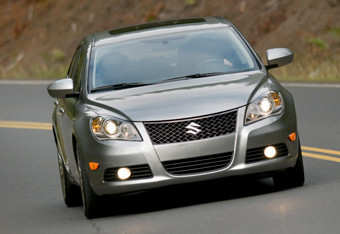
DETROIT – American Suzuki Motor Corp. sales have been in a freefall since the U.S. recession first hit in late 2008.
A glance at the numbers makes it easy to believe rumors that Suzuki soon will exit the market, with sales tumbling from a record 101,884 units in 2007 to just 23,994 last year, marking a 38% drop from 2009.
Not so, say company officials, who argue luring a new type of buyer to Suzuki might be taking longer than anticipated but is progressing none-the-less.
The Japanese parent is “very patient,” ASMC President Kevin Saito tells Ward’s in a recent interview here, as Suzuki tries to woo customers with vehicle styling, performance and value for the money, rather than low prices and incentives.
“It is a very good product lineup, quite sporty and very attractive, and our customer profile may change because of that,” he says. “Because of (our new product lineup), we have to change our business scenario.”
The past business model included vehicles co-developed with GM Daewoo Auto & Technology Co. in Korea, in which Suzuki held a small stake through its partnership with the former General Motors Corp.
The cars had quality issues, needed heavy incentives to sell, were pushed on fleets and largely appealed to subprime-credit customers, says Steve Younan, director-marketing and product planning.
Suzuki now is moving, albeit slowly, in the right direction, attracting a well-heeled buyer seeking style, performance and value, he says.

This is largely due to the new Kizashi midsize sedan developed in-house by Suzuki, which sold 6,138 units in 2010, Ward’s data shows.
While that may seem a low number compared with the Toyota Camry and Honda Accord’s 300,000-plus units each, and far short of Suzuki’s previously unannounced 12,000-unit annual target, Younan isn’t bothered.
He says Suzuki has been selling near 1,000 Kizashis a month, putting it within range of its annual bogey. Ward’s data shows Kizashi deliveries totaled 869 units in December and 729 in November.
“We were in launch phase last year, so our sales were growing every month after we launched the car (in December 2009),” Younan says of Kizashi. “As we launch some new advertising this year, we expect to continue that momentum.”
The marketing campaign for the car, “Kizashi Kicks,” launched Dec. 25 and focuses on the top-20 markets where Suzuki dealers prosper, which mainly are in the South and Northeast, Younan says. Ads eventually will run in the Pacific Northwest, as well.
The ads showcase the Kizashi taking on midsize luxury sedans. In a feat for Suzuki, the commercials will air on primetime network TV, including during the Grammy Awards next month on CBS and also on the Fox network’s “American Idol.”
Younan says the Kizashi is hitting Suzuki’s targeted demographics: young, performance-oriented males with prime credit. He does not provide specifics, other than two-thirds of buyers are new to the brand.
Suzuki predicted in late 2009 Kizashi customers would have a median age of 40 and an annual household income of $75,000. Some 55% of buyers were expected to be male, 70% with no children and 75% with a college degree.
Many car reviews have mentioned the Kizashi’s “tweener” status, sized between a compact and midsize sedan. So far, complaints the vehicle is too small fall far down the list of reasons buyers reject the car, Younan says. “We anticipated more of a barrier in that area, and actually it hasn’t materialized yet.”
Suzuki bases the Kizashi’s 12,000-unit sales target on the industry’s current seasonally adjusted annual rate of 12 million units. Should the industry return to 15 million-16 million units, the auto maker’s expectations could go as high as 24,000 units, for which it has the available capacity to handle.
Suzuki officials have said the Sagara, Japan, plant where the car is built has a 50,000-unit annual capacity.
The auto maker said at the sedan’s 2009 launch it hoped to one day offer a V-6 or hybrid-electric-powertrain option in addition to the current 185-hp 2.4L DOHC 4-cyl. But those plans were derailed by Suzuki’s breakup with the former General Motors Corp.
However, now that Volkswagen AG holds a stake in the Japanese car company, Younan says other options, including VW engines, are being considered. The relationship with VW has yet to yield many details on collaborations, he admits, but it takes time to see where synergies lie.
“Our whole product cadence got pushed back because of this relationship,” Younan says. “We had to slowdown our process to see what we could take advantage of and what they could take advantage of. It’s taking longer than we thought.”




